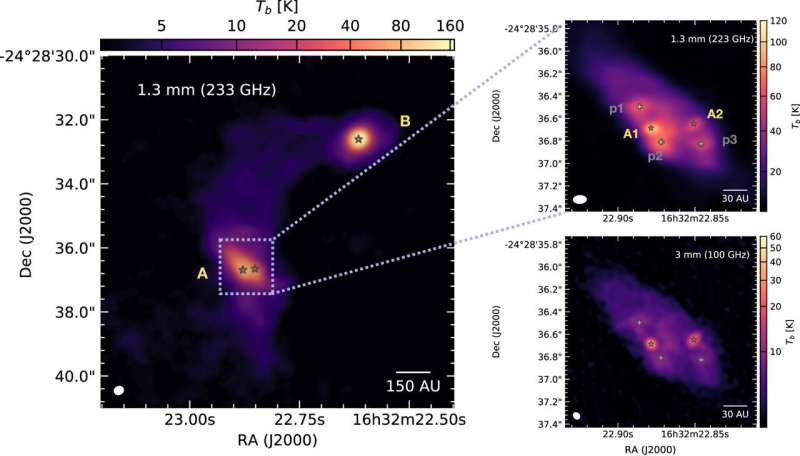December 29, 2022 report
Action of two protostars appears to be making conditions right for planet formation

A team of researchers at Max Planck Institute for Extraterrestrial Physics, working with a colleague at the University of Texas at Austin and another from Green Bank Observatory in West Virginia, has found evidence of ripe conditions for planet formation in the vicinity of two closely orbiting protostars.
In their paper published in The Astrophysical Journal Letters, the group describes their observations and outline what might be learned from future study of the star system.
The work by the team on this new effort came on the heels of work done by another team that discovered a pair of protostars still in the very early stages of their development—in their first 500,000 years of existence. In this new effort, the researchers have taken a closer look at the two protostars and also the environment in which they exist.
The two protostars currently share a name, IRAS 16293-2422 A and exist in a dense cloud of dust. They are also orbiting around a common center of gravity. In studying the protostars, which the researchers refer to as A1 and A2, they found that they are orbiting one another very closely—just 54 au apart. They also noted that the two stars are stirring up the dust around them—so much so that at least three hot spots have been identified.
The researchers suggest that the hot spots are due to shock waves sent into the dust cloud as A1 and A2 pull in some material to help them grow, and expel other material that does not mesh well with ingredients already present. Such shock waves, they note, lead to compression of dust and gases, which leads to heating. But they also note that it can lead to squeezing molecules tighter together, which can lead to the creation of more complex molecules. And when they combine with the dust around them, they can form rocks, which can grow larger as time passes. Eventually, as the stars mature, planets will have formed around them.
The researchers also note that some molecules in the hot spots have already formed into isocyanic acid, which is itself made up of carbon, oxygen, hydrogen and nitrogen—basic building blocks of organic molecules.
More information: María José Maureira et al, Dust Hot Spots at 10 au Scales around the Class 0 Binary IRAS 16293–2422 A: A Departure from the Passive Irradiation Model, The Astrophysical Journal Letters (2022). DOI: 10.3847/2041-8213/aca53a
Journal information: Astrophysical Journal Letters
© 2022 Science X Network


















